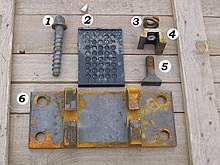Rail fastening system
The components of a rail fastening system may also be known collectively as other track material, or OTM for short.Eventually the flanged T rail became commonplace on all the world's railways, though differences in the fixing system still exist.Historically, a ceremonial Golden Spike driven by Leland Stanford connected the rails of the First Transcontinental Railroad across the United States.[7] The railroad spike was an invention which resulted from the state of industrialisation in the United States in the early 19th century: English mainline railways of that period used heavy and expensive cast iron chairs to secure T-shaped rails; instead, Stevens added a supporting base to the T rail which could be fixed with a simple spike.[17] The chair screw was first introduced in 1860 in France (French tire-fond) and became common in continental Europe.[21] They are thought more effective than spikes and screws and so are used in positions such as switch (point) tieplates[22] and on sharp curves.The spring spike holds the rail down and prevents tipping and also secures the baseplate to the sleeper.[30][31] Manual hole drilling and spike or screw insertion and removal have been replaced by semi-automated or automated machines, which are driven electrically, by pneumatics, by hydraulics, or are powered by a two-stroke engine.[36] The wooden keys were formed from oak, steam softened and then compressed with hydraulic presses and stored in a drying house.When inserted into the chair, exposure to the wet atmosphere caused the key to expand, firmly holding the rail.The tie plate increases bearing area and holds the rail to correct gauge.
- Screw for fixing plate to sleeper
- Elastomeric pad supporting rail
- Tension washer
- Rail clamp
- Tensioning bolt (nut not shown)
- Baseplate










Unimograilroad tiesNorth AmericaBritish IslesAustralasiaAfricaflanged railfish bellied railRobert L. Stevensbridge railbull head railsgolden spikeTranscontinental RailroadRobert Livingston Stevensspike maulspikersUnited Statesspring washersstapletrenailsflanged T railrailroad tiespikesPandrolfishplatePermanent waypermanent way (history)Rail sabotageWilliam Hemingway MillsImperial College PressWayback MachineTracks(history)Axe tiesBallastBaulk roadBreather switchClip and scotchDate nailLadder trackMinimum radiusProfileTie/SleeperTransition curveBalloon loopClassification yardHeadshuntPocket trackJunctionGauntlet trackGuide barPassing loopTrack gaugedual gaugeRail tracktramway trackRail yardRailway electrificationoverhead linesthird railground-level power supplyRailway turntableTransfer table (traverser)Roll waySidingrefuge sidingSwitchTrack geometryWater craneWater troughSignallingAnti-trespass panelsBlock postBuffer stopCatch pointsDefect detectorDerailerGuard railInterlockingLevel crossingLoading gaugePlatform screen doorsRailway signalSignalling controlStructure gaugeSignal bridgeTell-taleTrain stopWayside hornCoaling towerMotive power depotRailway workshopPlatformRoundhousefor trainsfor goodsStationbuildingWater stopIndustrialMilitaryPrivate